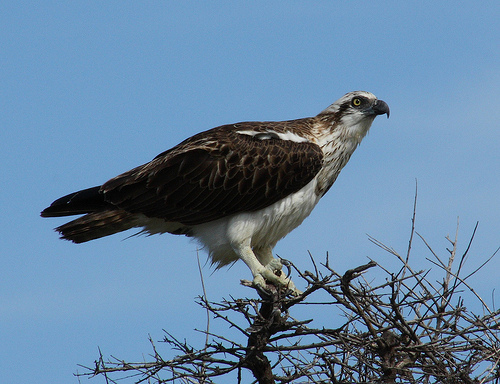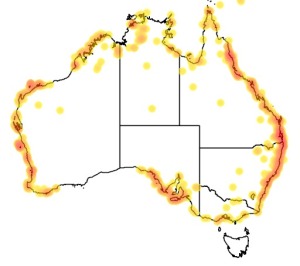
©David Witherall and Jodi Dyer: Osprey, Pandion haliaetus, Ocean Free, Green Island, used the boat mast as a lookout
Colours
Distinguishing features
The upperparts are a deep, glossy brown, while the breast is white and sometimes streaked with brown, and the underparts are pure white. The head is white with a dark mask across the eyes, reaching to the sides of the neck. The irises of the eyes are golden to brown, and the transparent nictitating membrane is pale blue. The bill is black, with a blue cere, and the feet are white with black talons. A short tail and long, narrow wings with four long, finger-like feathers, and a shorter fifth, give it a very distinctive appearance.
The sexes appear fairly similar, but the adult male can be distinguished from the female by its slimmer body and narrower wings. The breast band of the male is also weaker than that of the female, or is non-existent, and the underwing coverts of the male are more uniformly pale. It is straightforward to determine the sex in a breeding pair, but harder with individual birds.
Juveniles may be identified by buff fringes to the plumage of the upperparts, a buff tone to the underparts, and streaked feathers on the head. During spring, barring on the underwings and flight feathers is a better indicator of a young bird, due to wear on the upperparts.
In flight, it has arched wings and drooping "hands", giving it a gull-like appearance. (Wikipedia)
Size
- From 60 cm to 66 cm (Length of specimen) - applies to Females
- From 50 cm to 55 cm (Length of specimen) - applies to Males
Wingspan
- From 127 cm to 180 cm
Synonyms
Distribution
Distribution and habitat preferences
It is the second most widely distributed raptor species, after the Peregrine Falcon. It has a worldwide distribution and is found in temperate and tropical regions of all continents except Antarctica. (Wikipedia)
Audio recordings
Recorded at Napo: 'Cabañas San Isidro', 1-2 km SW Cosanga in Ecuador
© John V. Moore
(source)
Diet
Fish make up 99% of its diet. It typically takes fish about 25–35 cm in length, but the weight can range from 50 to 2,000 g. Virtually any type of fish in that size range can be taken.
They have vision that is well adapted to detecting underwater objects from the air. Prey is first sighted when it is 10–40 m above the water, after which the bird hovers momentarily then plunges feet first into the water.
It is particularly well adapted to this diet, with reversible outer toes, sharp spicules on the underside of the toes, closable nostrils to keep out water during dives, and backwards-facing scales on the talons which act as barbs to help hold its catch.
Occasionally, it may prey on rodents, rabbits, hares, amphibians, other birds, and small reptiles. (Wikipedia)
(Wikipedia)




